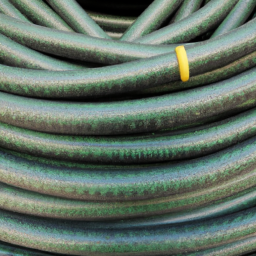What Thread Is A Garden Hose An Explainer
Table of Contents []
What Thread Is A Garden Hose
What is a Garden Hose Thread?
The term garden hose thread (GHT) typically refers to a kind of thread coupling and connection system widely used in North America. It is standard practice for most water hoses worldwide and is also referred to as internal American Standard Thread or ITT. GHT3 is the most common type of thread in hoses, particularly for watering gardening. These threads come in two common sizes, GHT3/16 and GHT3/8.
Features of GHT
Solvent Weld You Can Trust
GHT's solvent weld technology gives access to secure connections suitable for most water-based applications anywhere in your household. With heat and pressure the two surfaces of the hose are melted together, creating an air- and liquid-tight seal. Through this weld technique, it provides a lot of confidence, especially in home plumbing.
Burst Pressure Strength
Garden hose thread has been tested by certified laboratories for burst pressure strength up to 400 psi. This feature gives confidence that the GHT hose won't break under normal conditions.
Wide Range of Color
GHT provides a wide range of colors from which you can choose instead of the conventional black and green designs, allowing you to add extra style and color to your garden or landscape.
Benefits of GHT
Pressure Durability
Garden hoses with GHTsing are generally pressure-resistant and durable against all weathers. This allows the hoses to remain in their effective condition for a longer time so you don't have to worry about frequent replacements.
Cost-Effectiveness
GHT hoses are more cost-effective compared to other hoses due to their ease of use. Their lightweight and flexible design make them easy to install, maintain, and use.
Compatibility
GHT hose threads are compatible with standard GHT spigots, spray nozzles, and other related GHT accessories. This makes GHT hoses easier to fit into the most popular connections worldwide.
Pros and Cons of GHT
Pros
- Solvent weld technology
- High burst pressure strength
- Wide range of colors
- Pressure-resistant and durable
- Lightweight and flexible
- Easy to install, maintain, and use
- Compatible with GHT accessories
Cons
- Length limitations of hoses
- Possibility of becoming stiffened in colder weather
- Somewhat challenging to store and use
- Vulnerable to long-term wear and tear
- GHT accessories may be harder to find outside North America
Case Studies
Case Study 1
Father of 2 Jake purchased a 50-foot-long GHT hose from a local store for his garden. He appreciated the flexible design of his new hose and also its durability against the weather. He had to fix a few GHT accessories into the hose due to their compatibility. After a few months of use, Jake still remains content with his purchase.
Case Study 2
Kate, an avid gardener, faced an issue with her 25-foot-long GHT hose's durability. Her hose was not able to survive the cold winter season, making it difficult for her to carry out her gardening activities. After consulting with the seller, they found out that she had used the GHT hose in cold conditions which caused it to become stiffened.
FAQs
How strong is a GHT hose?
A GHT hose has been tested for burst pressure strength of up to 400 psi.
What kind of accessories are compatible with GHT hoses?
GHT hoses are compatible with standard GHT accessories which include GHT spigots, sprinklers, spray nozzles, and so on.
Does a GHT hose come in different colors?
Yes, GHT hoses come in a wide range of colors, not just the conventional black and green.
Mistakes People Make
Using Too Long a Hose
Most GHT hoses are designed for a length of up to 25 feet, but some users end up buying 50 feet for their garden. This leads to the hose weighing down heavily on the surface, making it difficult for them to move around.
Not Storing the Hose Properly
GHT hoses are lightweight and flexible which require the user to store them properly. If the hose isn't stored correctly, it may lead to damage to the hose itself.
Using the Hose in Extreme Weather Conditions
In cold weather conditions, some GHT hoses become stiffened, leading to difficulty in operating the hose. This could be due to users using the hose for a much longer period than expected.
Best Practices
Storing GHT Hoses Properly
Since GHT hoses are lightweight and flexible, they are prone to damage if stored incorrectly. It is essential to store the hose in a cool, dry place, preferably in a shaded area during warm weather.
Checking For Leaks
It is a good practice to check for any leaks in the GHT hose before use. This allows users to replace faulty parts and therefore, enjoy a better overall experience.
Cleaning the Hose Timely
It is important to keep the hose clean. This removes any grime and dirt which may have collected over time, leading to a clean experience.
Handling the Hose Carefully
GHT hoses are lightweight and fragile, which is why it is important to handle them with care. Also, users should avoid excessive twisting of the hose in order to keep it in its effective condition.
Summary
GHT hoses are popular in North America and are becoming increasingly popular worldwide. They have features like solvent weld technology, high burst pressure strength, and come in a wide range of colors. The benefits of using GHT hoses are they are pressure-resistant and durable, cost-effective, compatible with GHT accessories and much more. There are several mistakes people make when using GHT hoses such as using too long a hose, not storing it correctly, and using it in extreme weather conditions. To ensure the best experience from using a GHT hose, users should follow certain best practices such as storing the hose properly, checking for leaks, cleaning the hose timely, and handling it with care.

Previous Page
Next Page
